1 min read
Galaxies IC 2163 and NGC 2207 (Hubble and Webb Images Side by Side)
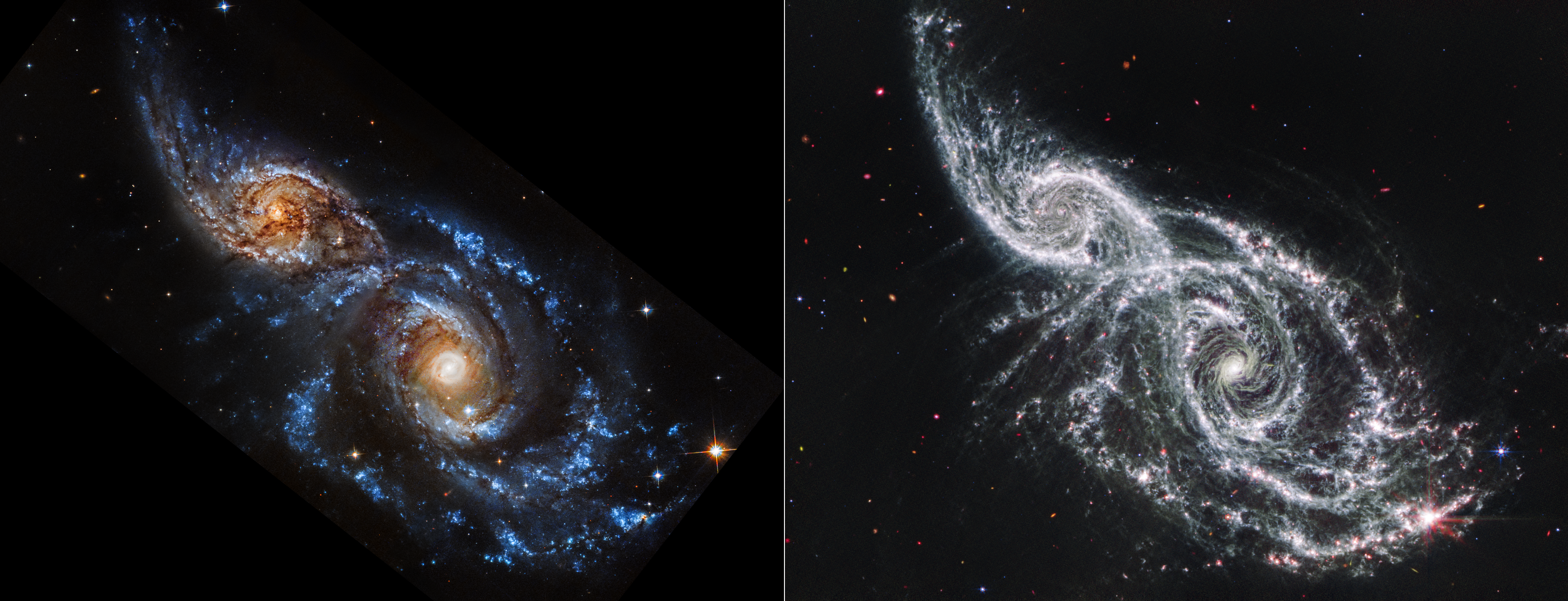
These are two views of the same scene, each showing two overlapping spiral galaxies, IC 2163 at left and NGC 2207 at right. The Hubble Space Telescope’s ultraviolet- and visible-light observation is at left, and the James Webb Space Telescope’s mid-infrared light observation is at right.
In Hubble’s image, the star-filled spiral arms glow brightly in blue, and the galaxies’ cores in orange. Both galaxies are covered in dark brown dust lanes, which obscures the view of IC 2163’s core at left.
In Webb’s image, cold dust takes center stage, casting the galaxies’ arms in white. Areas where stars are still deeply embedded in the dust appear pink. Other pink regions may be objects that lie well behind these galaxies, including active supermassive black holes known as quasars.
Turn your eye toward the bottom right of the Webb image. The largest, brightest pink region that glimmers with eight prominent diffraction spikes is a mini starburst — a location where many stars are forming in quick succession. The same region in the Hubble image appears as a bright blue cluster of stars.
The lace-like holes in the white spiral arms of Webb’s images are often where supernovae exploded long ago. In the same regions, Hubble shows these areas are now populated with newer stars.
The black areas to upper right and lower left of the Hubble image do not contain any data.
Extended Description and Image Alt Text
Extended Description
Two views of the same object are shown side by side, split evenly. The Hubble ultraviolet and visible light observation is at left, and the Webb mid-infrared observation is at right. Both show an angled pair of spiral galaxies, IC 2163 at top left, and NGC 2207, at bottom right. They appear to be overlapping at the center diagonal, with the smaller IC 2163 behind the larger NGC 2207.
Hubble’s Ultraviolet and Visible Light View
In the Hubble image, the galaxies’ cores appear white at the center, and more orange overall. IC 2163 has dark brown, irregularly shaped dust lanes covering is core. The smaller IC 2163 has two prominent spiral arms that wind clockwise, and become straighter at the ends. The arms are bluer, and brighter near the core, but are also covered in brown dust lanes. The straighter edges of the spiral arms are bluer. NGC 2207 has a small white core surrounded by a white ring made from a haze of stars. The galaxy also has dust lanes that are clearest near to its core, and more that lie beyond but are harder to pick out. Its prominent blue spiral arms are irregular, but significantly larger. Tiny galaxies and a few foreground stars dot the black background of space. Since the image is rotated to match the Webb image, there are no data along the bottom left, top right, and bottom right corners.
Webb’s Mid-Infrared Light View
In the Webb image, the galaxies’ cores appear bright white, transitioning to spiral arms that are also bright white, but flecked with pink dots. IC 2163 shows thin, highly detailed, winding dust lanes and spiral arms that start at the core. Its arms follow the same paths, becoming straighter toward the edges. At right, NGC 2207 also has a bright white core, which is immediately surrounded by thinner dust lanes. It has wider spiral arms than IC 2163 that wind counter clockwise. The arms are irregular, forming a wider, rougher spiral shape. Tiny galaxies and a few foreground stars dot the entire black background of space.
Image Alt Text
Two views of the same object are shown side by side, split evenly. The Hubble observation is at left, and the Webb observation is at right. Both show an angled pair of spiral galaxies, IC 2163 at top left, and NGC 2207, at bottom right.
About the Object
- R.A. PositionR.A. PositionRight ascension – analogous to longitude – is one component of an object's position.06:16:24.9
- Dec. PositionDec. PositionDeclination – analogous to latitude – is one component of an object's position.-21:22:26
- ConstellationConstellationOne of 88 recognized regions of the celestial sphere in which the object appears.Canis Major
- DistanceDistanceThe physical distance from Earth to the astronomical object. Distances within our solar system are usually measured in Astronomical Units (AU). Distances between stars are usually measured in light-years. Interstellar distances can also be measured in parsecs.114 million light-years
About the Data
- Data DescriptionData DescriptionProposal: A description of the observations, their scientific justification, and the links to the data available in the science archive.
Science Team: The astronomers who planned the observations and analyzed the data. "PI" refers to the Principal Investigator.This image was created with Hubble data from proposal: 6483 (D. Elmegreen) and Webb data from proposal 6553 (M. Garcia Marin). Image Processing: Joseph DePasquale (STScI)
- InstrumentInstrumentThe science instrument used to produce the data.Hubble: WFPC2; Webb: MIRI
- Exposure DatesExposure DatesThe date(s) that the telescope made its observations and the total exposure time.Hubble: May 25, 1996; November 11, 1998; Webb: January 26, February 2, 2024
- FiltersFiltersThe camera filters that were used in the science observations.Hubble: F439W, F555W, F814W; Webb: F770W, F1130W, F1500W
- Object NameObject NameA name or catalog number that astronomers use to identify an astronomical object.IC 2163 and NGC 2207
- Object DescriptionObject DescriptionThe type of astronomical object.Spiral Galaxies
- Release DateOctober 31, 2024
- Science Release‘Blood-Soaked’ Eyes: NASA’s Webb, Hubble Examine Galaxy Pair
- CreditImage: NASA, ESA, CSA, STScI

These images are a composite of separate exposures acquired by the Hubble and James Webb Space Telescopes using Hubble's WFPC2 and Webb's MIRI instruments. Several filters were used to sample wide wavelength ranges. The color results from assigning different hues (colors) to each monochromatic (grayscale) image associated with an individual filter. In this case, the assigned colors are: Hubble - Blue: F439W Green: F555W Red: F814W, Webb - Blue: F770W, Green: F1130W, Red: F1500W
Related Images & Videos
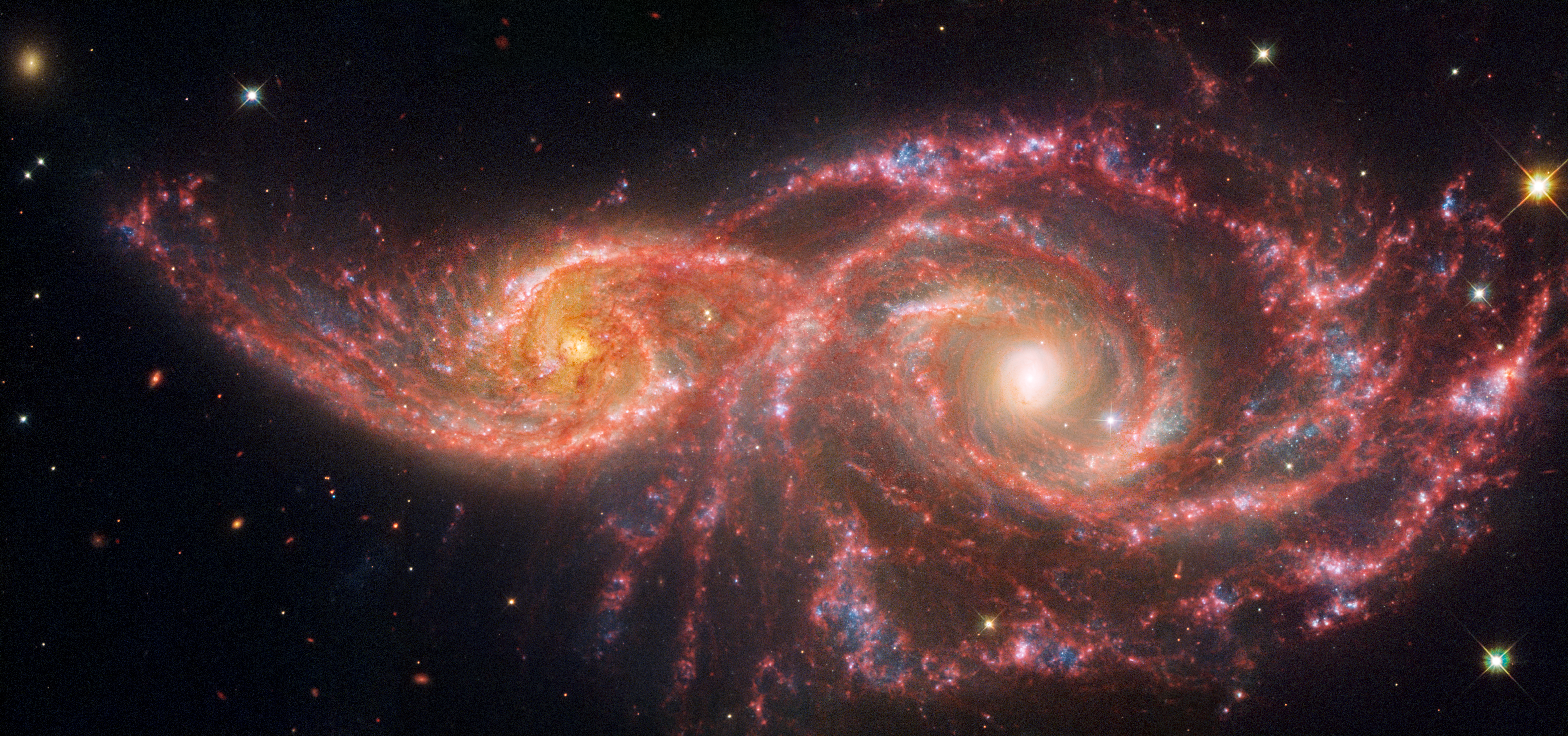
Galaxies IC 2163 and NGC 2207 (Webb and Hubble Image)
The gruesome palette of these galaxies is owed to a mix of mid-infrared light from NASA’s James Webb Space Telescope, and visible and ultraviolet light from NASA’s Hubble Space Telescope. The pair grazed one another millions of years ago. The smaller spiral on the left,...
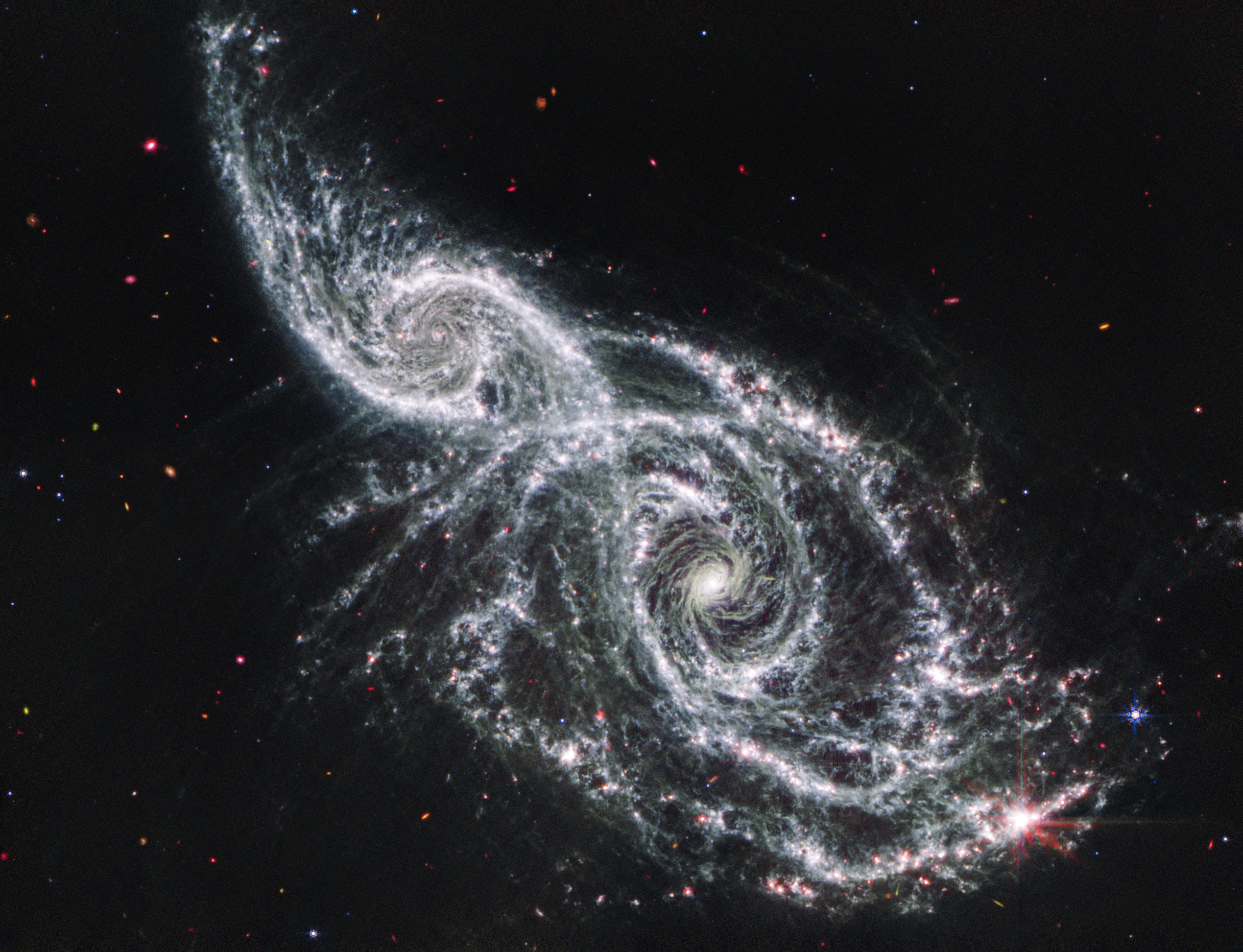
Galaxies IC 2163 and NGC 2207 (Webb MIRI Image)
The James Webb Space Telescope’s mid-infrared image of galaxies IC 2163 and NGC 2207 recalls the iciness of long-dead bones mixed with eerie vapors. Two large luminous “eyes” lie at the galaxies’ cores, and gauzy spiral arms reach out into the vast distances of space. Webb’s...
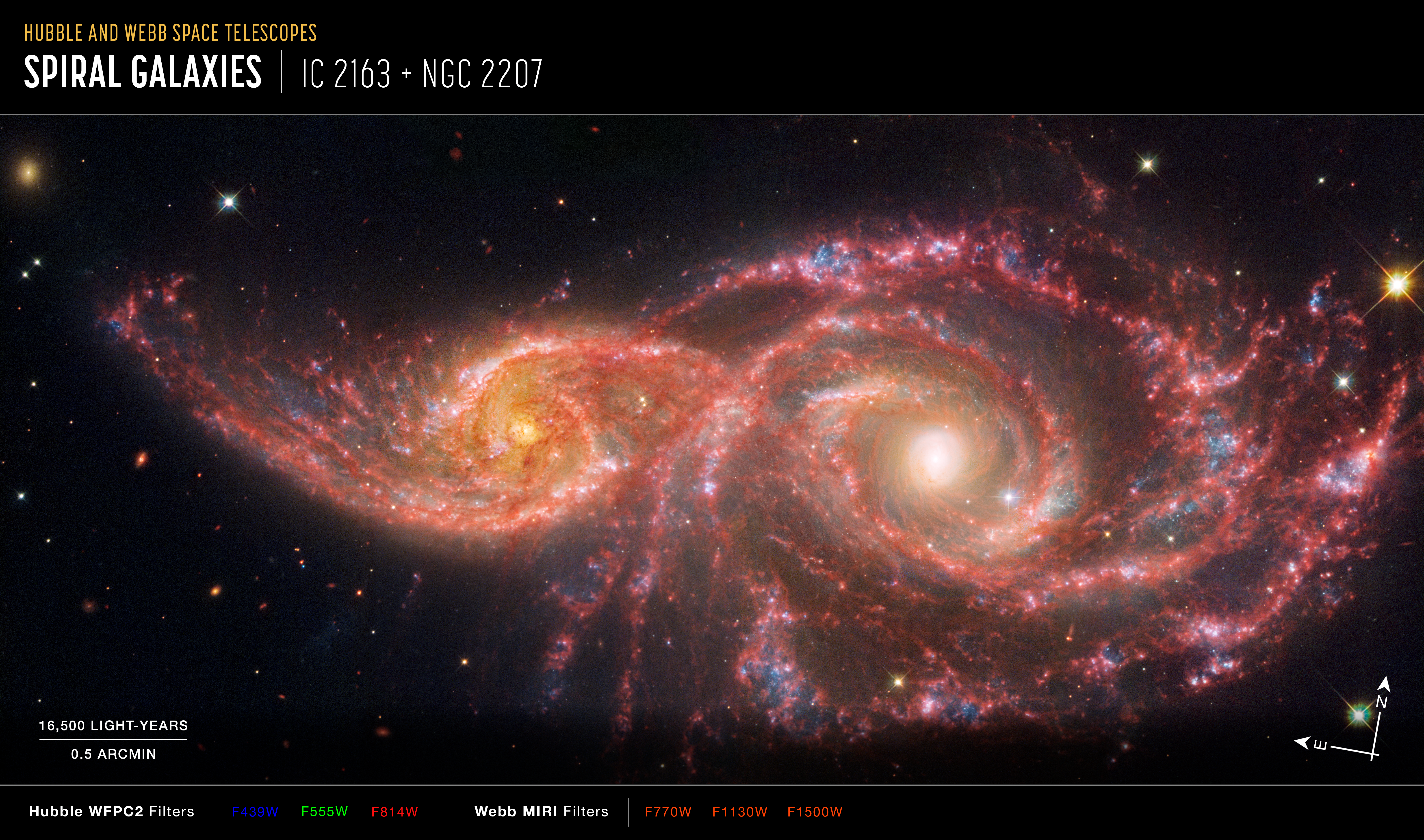
Galaxies IC 2163 and NGC 2207 (Webb and Hubble Compass Image)
This image of galaxies IC 2163 and NGC 2207, captured by the Hubble and James Webb space telescopes. Hubble’s data are from its Wide Field Planetary Camera 2 (WFPC2). Webb’s data are from its MIRI (Mid-Infrared Instrument). The image shows a scale bar, compass arrows, and color...
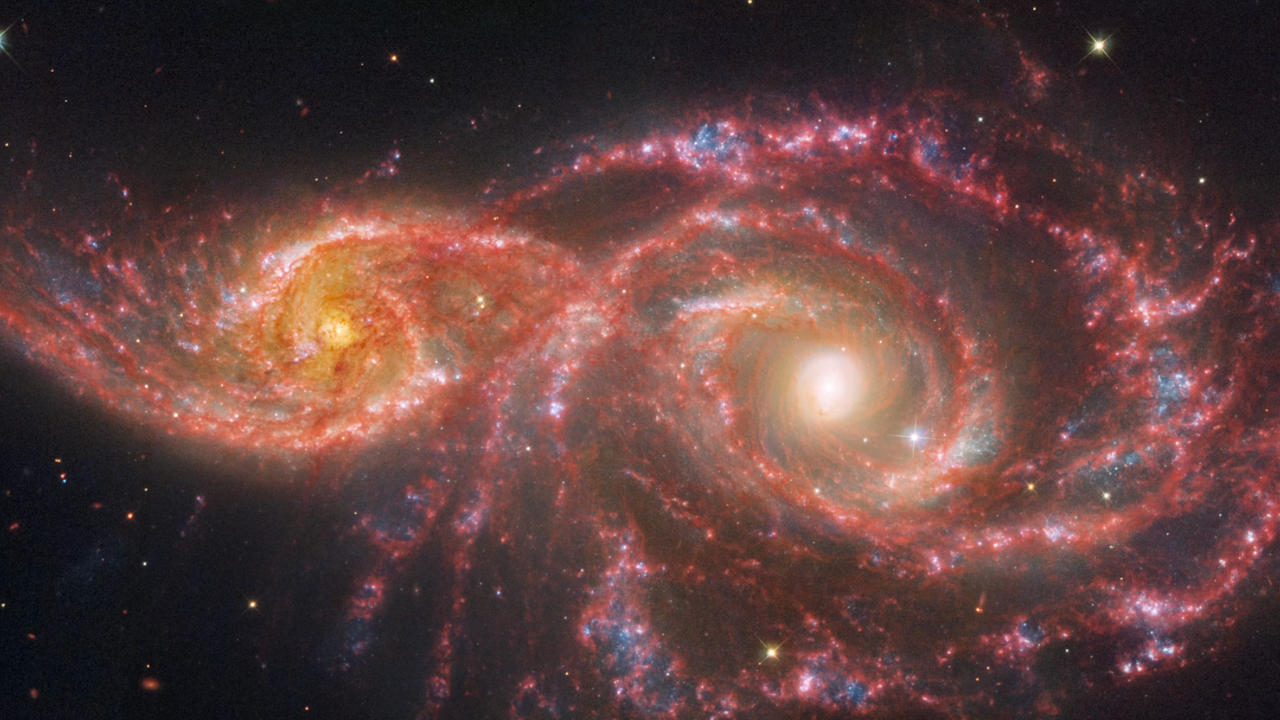
A Tour of IC 2163 and NGC 2207
This video tours a pair of spiral galaxies, IC 2163 at left and NGC 2207 at right, which reside 114 million light-years from Earth. The journey begins and ends on a new image that combines mid-infrared, visible, and ultraviolet light from the James Webb and Hubble space...
Share
Details
Laura Betz
NASA’s Goddard Space Flight Center
Greenbelt, Maryland
laura.e.betz@nasa.gov
NASA, ESA, CSA, STScI




























